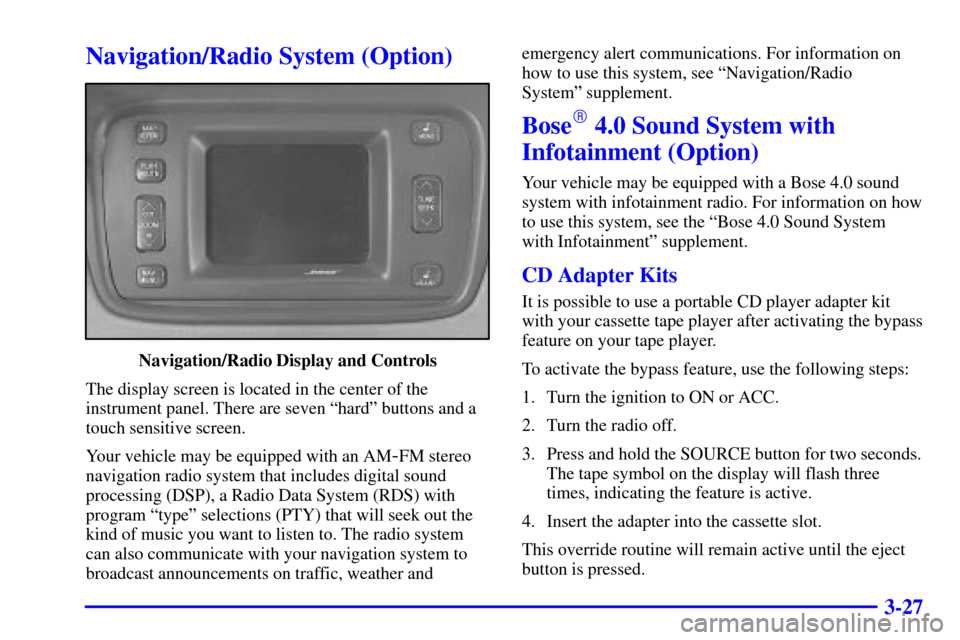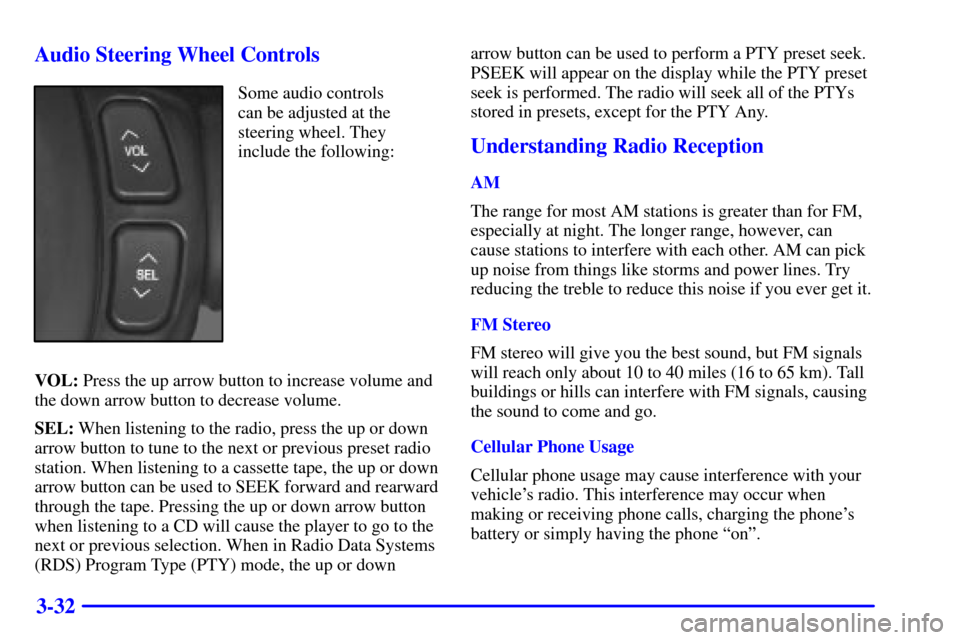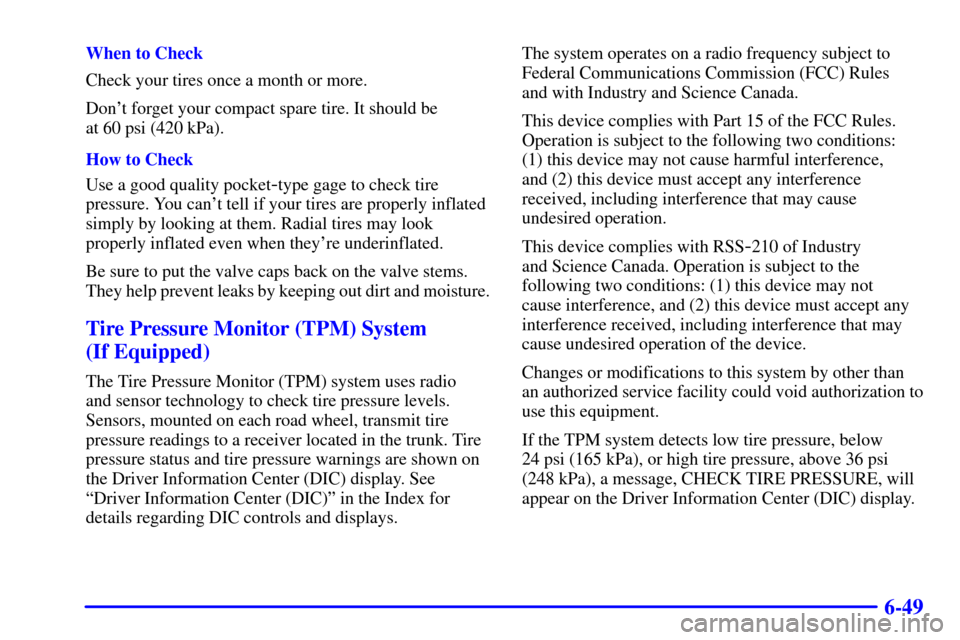Page 206 of 371

3-27
Navigation/Radio System (Option)
Navigation/Radio Display and Controls
The display screen is located in the center of the
instrument panel. There are seven ªhardº buttons and a
touch sensitive screen.
Your vehicle may be equipped with an AM
-FM stereo
navigation radio system that includes digital sound
processing (DSP), a Radio Data System (RDS) with
program ªtypeº selections (PTY) that will seek out the
kind of music you want to listen to. The radio system
can also communicate with your navigation system to
broadcast announcements on traffic, weather andemergency alert communications. For information on
how to use this system, see ªNavigation/Radio
Systemº supplement.
Bose� 4.0 Sound System with
Infotainment (Option)
Your vehicle may be equipped with a Bose 4.0 sound
system with infotainment radio. For information on how
to use this system, see the ªBose 4.0 Sound System
with Infotainmentº supplement.
CD Adapter Kits
It is possible to use a portable CD player adapter kit
with your cassette tape player after activating the bypass
feature on your tape player.
To activate the bypass feature, use the following steps:
1. Turn the ignition to ON or ACC.
2. Turn the radio off.
3. Press and hold the SOURCE button for two seconds.
The tape symbol on the display will flash three
times, indicating the feature is active.
4. Insert the adapter into the cassette slot.
This override routine will remain active until the eject
button is pressed.
Page 211 of 371

3-32 Audio Steering Wheel Controls
Some audio controls
can be adjusted at the
steering wheel. They
include the following:
VOL: Press the up arrow button to increase volume and
the down arrow button to decrease volume.
SEL: When listening to the radio, press the up or down
arrow button to tune to the next or previous preset radio
station. When listening to a cassette tape, the up or down
arrow button can be used to SEEK forward and rearward
through the tape. Pressing the up or down arrow button
when listening to a CD will cause the player to go to the
next or previous selection. When in Radio Data Systems
(RDS) Program Type (PTY) mode, the up or downarrow button can be used to perform a PTY preset seek.
PSEEK will appear on the display while the PTY preset
seek is performed. The radio will seek all of the PTYs
stored in presets, except for the PTY Any.
Understanding Radio Reception
AM
The range for most AM stations is greater than for FM,
especially at night. The longer range, however, can
cause stations to interfere with each other. AM can pick
up noise from things like storms and power lines. Try
reducing the treble to reduce this noise if you ever get it.
FM Stereo
FM stereo will give you the best sound, but FM signals
will reach only about 10 to 40 miles (16 to 65 km). Tall
buildings or hills can interfere with FM signals, causing
the sound to come and go.
Cellular Phone Usage
Cellular phone usage may cause interference with your
vehicle's radio. This interference may occur when
making or receiving phone calls, charging the phone's
battery or simply having the phone ªonº.
Page 331 of 371

6-49
When to Check
Check your tires once a month or more.
Don't forget your compact spare tire. It should be
at 60 psi (420 kPa).
How to Check
Use a good quality pocket
-type gage to check tire
pressure. You can't tell if your tires are properly inflated
simply by looking at them. Radial tires may look
properly inflated even when they're underinflated.
Be sure to put the valve caps back on the valve stems.
They help prevent leaks by keeping out dirt and moisture.
Tire Pressure Monitor (TPM) System
(If Equipped)
The Tire Pressure Monitor (TPM) system uses radio
and sensor technology to check tire pressure levels.
Sensors, mounted on each road wheel, transmit tire
pressure readings to a receiver located in the trunk. Tire
pressure status and tire pressure warnings are shown on
the Driver Information Center (DIC) display. See
ªDriver Information Center (DIC)º in the Index for
details regarding DIC controls and displays.The system operates on a radio frequency subject to
Federal Communications Commission (FCC) Rules
and with Industry and Science Canada.
This device complies with Part 15 of the FCC Rules.
Operation is subject to the following two conditions:
(1) this device may not cause harmful interference,
and (2) this device must accept any interference
received, including interference that may cause
undesired operation.
This device complies with RSS
-210 of Industry
and Science Canada. Operation is subject to the
following two conditions: (1) this device may not
cause interference, and (2) this device must accept any
interference received, including interference that may
cause undesired operation of the device.
Changes or modifications to this system by other than
an authorized service facility could void authorization to
use this equipment.
If the TPM system detects low tire pressure, below
24 psi (165 kPa), or high tire pressure, above 36 psi
(248 kPa), a message, CHECK TIRE PRESSURE, will
appear on the Driver Information Center (DIC) display.